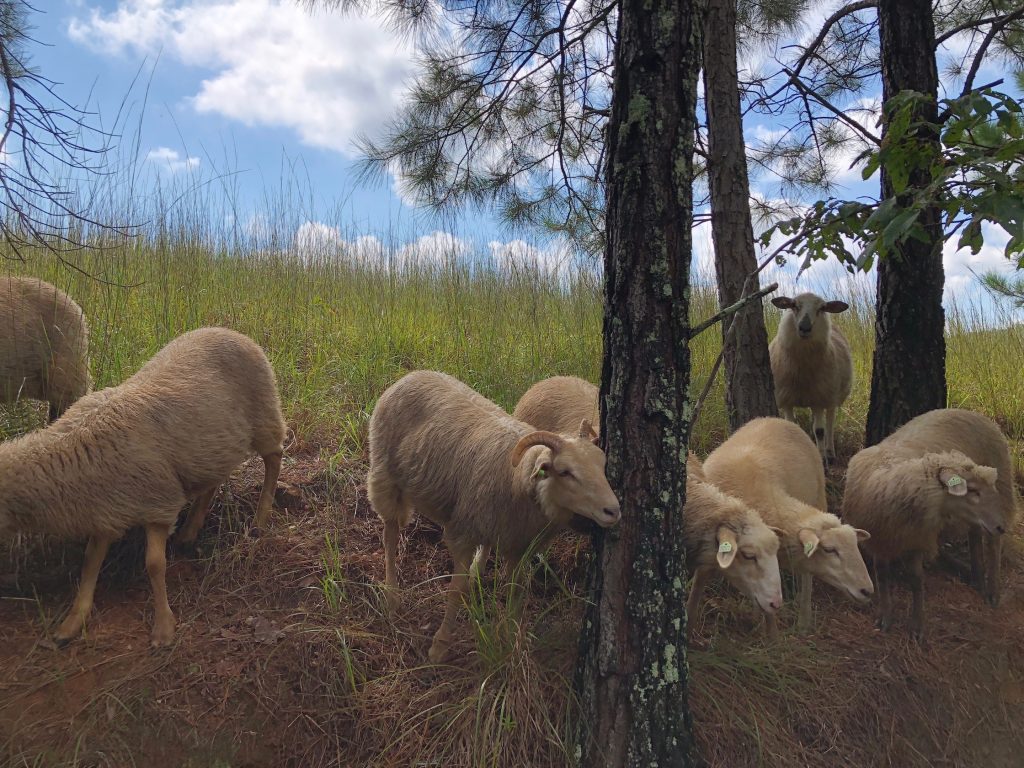Wool
fleece + roving + handspun yarn
SE2SE Stickers Available!
The Shave ‘Em 2 Save ‘Em program is an initiative started by the Livestock conservancy to help save endangered species like our Gulf Coast sheep. If you’d like more information on getting started with this interactive conservation efforts, get your passport here.
Technical Specs
- Cruelty free processing
- Pasture raised sheep with plenty of grazing
- Gulf Coast sheep with pedigree available
- Sustainably harvested, spun, and dyed
- Micron measurement: 24-25 micrometer

Wool products
View us atRedOakFarmWoolon Etsy
About Red Oak Wool
Growing a great fleece takes a full year. The quality of our sheep’s fleeces is a direct result of their environment and diet. Poor nutrition, illness, and stress express themselves in wool breaks, poor staple length, and sparse growth. Our sheep are well cared for every day of the year, mostly because we love them, but this also results in wonderful, buttery soft, high quality wool. We work pretty hard on pasture management as this is the cornerstone of the sheep’s nutrition. Through rotational grazing and cross species interaction, we work to provide ecologically balanced and diverse forage for the sheep. Our pastures are filled with a diverse array of grasses, forbs, wildflowers, and legumes. We never use herbicides or pesticides, but rather cultivate diversity and balance.
Each Spring, the traveling shearer visits the farm. This brings a flurry of activity from the family, dogs, chickens, ducks, horses, and helping hands to prepare for a happy and smooth shearing day. The sheep are brought into the spring cleaned barn and given a light supper. The postures for the sheep during the shearing process are uncomfortable for them on a full belly, so it is better for them to forego food for several hours before shearing begins. Shearing starts early in the morning and is complete by lunch. The wool is collected as a fleece, carefully tagged with the sheep’s name and tag number, and temporarily stored for later evaluation and skirting.
Once each sheep is sheared, they are immediately returned to the flock in the holding area. There’s usually a little confusion because the sheep look so markedly different after shearing. Sometimes a ewe’s lambs are confused, but usually within a couple of minutes, they all sort things out and get reacquainted.
Skirting is the process of separating out any vegetable matter, second cuts, manure tags and other unfavorables out of the fleece, and there is a surprising amount of really weird things that can be found in a fleece. Manure tags are saved because they make incredible natural bedding for the garden area by providing fertilization, insulation, and as a pest deterrent (cut worms, slugs, and snails can’t get through the fleece). Our skirted or raw fleeces are available for purchase.
Next, the fleece is sent off to be processed into roving (a fancy way of saying loose ropes of wool). Our local mill, Spirit Fiber Works, transforms our fleece from fluffy chunks of locks to combed fiber that is ready to spin. The mill washes, combs, and nearly aligns each fiber into roving with a slight lanolin feel. Roving is then available to you through our website, in a local guild meeting, and maybe in a farmers market or brick-and-mortar store soon.
Some lucky fiber is hand spun on a modern wheel by LB in the Atlanta area. Her mission is to spin and dye yarn and roving with dye stuff from the farm or surrounding area. Black walnut is harvested in the metro-Atlanta area, and pokeberries and goldenrod are collected once a year on the farm. Other dye stuff isn’t locally grown or readily available for cultivation in Georgia, like indigo and turmeric or souring soap. When this is the case, organic and fair-trade dye stuff is selected when it is available.





